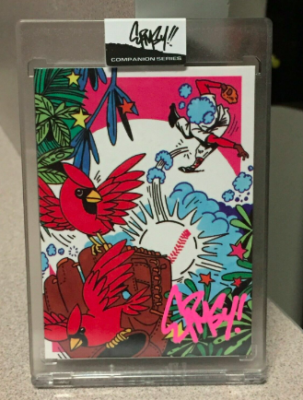Inside the Pack: Artist Baseball Cards Should Go Mainstream
One of the biggest hits of the 2020 baseball card product line involved artists creating baseball cards. But if you aren’t active on Twitter and don’t follow Topps’s online exclusive releases, you would never know. With so many new collectors having entered the market and the excitement around relic cards, manufactured relics, and serially numbered cards dwindling, pack-pulled artist cards would be a welcome addition to the hobby.
Artists have a long history with baseball cards. Topps used artwork on the 1952 and 1953 sets, but the artists were not recognized on the card and in some cases it still is not clear who the artist was. In the 1980s and 1990s, Donruss issued Diamond Kings cards drawn by artist Dick Perez (who graciously did an interview with me here). In more recent days, Topps has been highlighting artists in various ways. Sketch cards, which gained prominence in the non-sports card world in the 1990s, have been included in many Topps products. A sketch card is exactly what it sounds like – an artist creates a sketch on a blank baseball card, then usually signs it and numbers it 1/1. Topps has also used artist features like the Museum Canvas Collection insert sets. Additionally, Topps Fire credits the artist, like Tyson Beck, on the back of the card.

But what transpired in 2020 took artist cards to another dimension. Things heated up when Topps announced Project 2020, a year-long 400-card set that saw 20 artists reimagining 20 iconic Topps cards in their own style. Project 2020 became extremely hot for a brief period of time, with people flipping the cards for 10 or 20 times their sale price, before the market ultimately cooled. Still, each card sold thousands of copies. By the end, several of the artists were selling “companion cards” on their websites. These companion cards were designed to go along with the official Topps card, but were not sold through Topps and therefore do not depict the player or use the player or team name. Artists also began selling signed copies of the Project 2020 cards on their websites. If you don’t get daily Topps emails or aren’t active on Twitter with baseball card accounts, you likely missed all of this.
Lack of Topps emails might also cause you to miss the Topps Living Set. The set is modeled off the 1953 Topps design and sells 2 or 3 cards a week; cards are only available for a week, and the print run is announced after sales close. Since the beginning, Mayumi Seto has acted as the sole artist for these cards, but this week, Topps announced that Jared Kelley would also join the team and each would issue one card a week. With the cards available for just one week, and only online, you likely won’t find out about them if you aren’t active with online offerings.
With the success of Project 2020, Topps had artist Ben Baller, one of the breakout stars of the project, reimagine Topps Chrome. The company sold hobby boxes of Topps Chrome Ben Baller, but this was another online-only sale, which sold out in minutes. If it showed up in a hobby shop, the price was significantly higher than the sale price due to the high demand. Again, mainstream collectors who don’t pay attention online were shut out.
Now that Topps knows the demand for artist cards is there, it’s time to bring them into traditional products. These cards are unique and shake up the industry, and shouldn’t be reserved for online exclusives a fraction of the hobby market will see. If Gary Vaynerchuk gets his own insert set in a Topps flagship product, why not an artist? Rather than what seems to be an annual tradition of reprinting popular cards from across the years (something I’m sure will return for the company’s 70th anniversary this year), let’s have one of the Project 2020 artists reimagine these cards. I’d prefer a 25 card set of Efdot or Mister Cartoon renderings of famous cards to another reprint that looks the same as the other dozens of reprint sets over the years. How about some 1/1s buybacks? I’d love to see a 1991 Chipper Jones card with some street art-style graffiti by Sophia Chang on it, signed by her on the back. Give me some of Ermsy’s cartoon drawings on top of a 1987 Barry Bonds. These things are exciting, different, and – most importantly – desirable.
Project 2020 helped make these artists well-known to a small percentage of card collectors. The demand is there. Given the successes that artist cards had, and continue to have, it’s time for Topps to take these artist cards mainstream and put them in traditional products.




